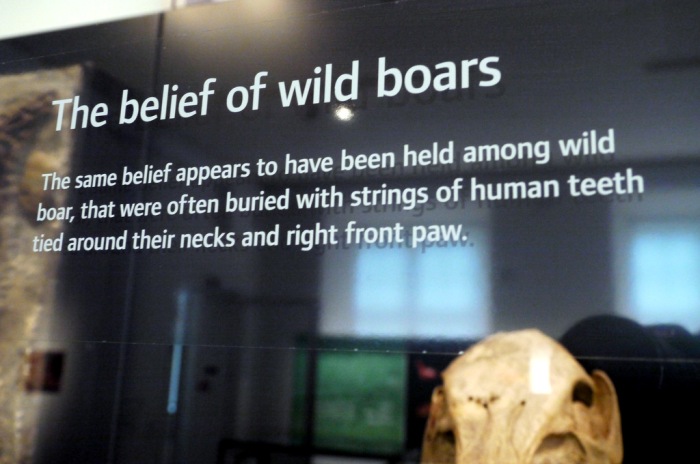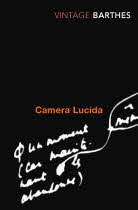Engagement through estrangement:
Barthes and Brecht visit the prehistoric museum

The same belief appears to have been held among wild boar, that were often buried with strings of human teeth tied around their necks and right front paw.
Bear with me…. this might be a long one. Hopefully, I’ll manage to be engaging while discussing engagement! This post draws together responses to recent blog posts about one big thinker (Barthes) and finally gets some thoughts from my undergraduate work about another big thinker (Brecht) into the open. Woven between these, is some stuff about prehistory in museums that I’ve been thinking about recently. By the end, you probably won’t know any more about the beliefs of Danish Mesolithic wild boar…. but that may be the point.
Barthes and punctum
Engagement has become such a buzzword in cultural and heritage studies that it sometimes becomes useless. For me, engagement means much more than just getting people-through-doors, bums-on-seats or clicks-on-pages. Engagement means that a person (museum visitor, website user, whatever) actually switches on and interacts with the presented material – critically and imaginatively.
I’m not remotely alone in this. For many friends and colleagues this appears to be the holy grail of any work with/for the public. In fact, this post was triggered by reading posts by John Coburn and Mia Ridge on Understanding Compelling Collections and ‘I see, I feel, hence I notice, I observe, and I think’ respectively.
Mia’s piece builds on John’s and incorporates Roland Barthes concepts of studium and punctum (nice summary by photographer George Powell). Essentially, studium is the basic, accepted ‘cultural, linguistic, and political interpretation of a photograph’ (Wikipedia’s definition): an understanding of what a photo depicts, where and when it was taken, and the reasons it was created. All photographs, argues Barthes, exist within a framework of this rationalised, fairly unemotional studium.
Barthes contrasts this with punctum: the arresting, personally touching, emotional or transcendent detail that reaches ‘through the photograph’ to establish a direct relationship between the viewer and the depicted. Punctum is a useful term for identifying a far-from-superficial element in the sorts of historic photographs that John discusses, the sorts of elements that are picked up by sites such as Retronaut. Punctum is the element that launches an exhibition, that creates curiosity, that bridges our way to the past. Mia points out that both studium and punctum can be useful concepts when discussing a broader range of images or artefacts, and on reading this I realised that I had been using the concept and renaming it ‘transcendance’ in a talk I gave at EAA 2012 in Helsinki.
Punctum and prehistory
At my talk – which was in a session of the Stone Age Bog Group – I talked about the fact that wetland sites are virtually the only sources for archaeological remains from the deep past that can create moments of transcendence (or as I now recognise Punctum). Footprints, head-dresses, sculpture, human remains: each of these create a flash of instant, emotional connection to people thousands of years ago. As such, I argued that they are an absolutely crucial tool for those trying to engage people with Stone Age hunter-gatherers because, as we all know, there aren’t many of us that can get excited about a load of old flint!
However, there is a danger that the emotional and imaginative response to such objects is overwhelming and that this becomes an obstacle to understanding and further engagement. The lifeways of Stone Age hunter-gatherers are unimaginably different from our own: no matter how far we get with the most sophisticated or sensitive syntheses of archaeological evidence and ethnographic comparison we cannot imagine our way back into the deep past. We would be projecting a myriad of assumptions about all sorts of things from gender to power, ownership to personhood, place, home and many more. The temptation to project ourselves into the deep past created by a sense of Punctum is very strong and it is in opposition to this temptation that I would like to place our next useful concept: this time stolen from playwright and theatre theorist Bertolt Brecht.
Verfremdungseffekt ‘an estrangement effect’
Brecht developed the notion of Verfremdungseffkt as part of his aesthetics of epic theatre. The technique is designed to collapse the suspension of disbelief, to deliberately break the ‘fourth wall’ : Essentially to force the audience to realise that they’re witnessing a fictive narrative, a performance, a construct. As they do so, it is hoped that their critical faculties will be engaged, not only with the drama and narrative but with the process of it’s construction and the material behind it. In Brecht’s Life of Gallileo estrangement is designed to help the audience reflect on the themes of dogmatic oppression and intellectual freedom – particularly striking when imagined on opening night in Zurich in 1943.
So, Verfremdungseffekt counters the too-easy emotional immersion in constructed narratives, while punctum creates an arresting emotional response to otherwise rationally understood images or objects. Punctum is, by its very nature, difficult to control. As Mia puts it:
‘Punctum is often personal to the viewer, but when it occurs it brings with it ‘a power of expansion’: ‘I see, I feel, hence I notice, I observe, and I think’. You cannot design punctum, but can we design collections interfaces to create the serendipitous experiences that enable punctum? Is it even possible with images of objects, or is it more likely to occur with photographic collections?’
Well, I would argue that for certain forms of evidence from prehistory the objects themselves have the strongest form of punctum and even with the sparsest framing, many people pick up on this very quickly. Often, however, those presenting the deep past create rich, immersive and seductive multimedia narratives on top of these objects which though captivating, do little to engage a viewer’s critical faculties. For example, it has long been argued that many forms of creative visualisation actually seduce audiences into a form of ‘archaeological tourism’ that completely hijacks any critical engagement (for more see my undergraduate thesis – if you must!). Cinematic 3D CGI is one of the most contentious forms of this:
The technical accomplishments and attention to detail of German studio Faber-Courtial is hard to fault but their material exemplifies an attempt at complete visual perfection. Anecdotally, I have found that this leads many viewers to either passively and totally accept such work as ‘fact’ or to pick on one detail “How can they know what the hairstyles were like!?!” and thereafter reject the entire piece and feel that their trust has been abused – disengaging them from the interpretation and the material.
It is here that the potential of the Verfremdungseffekt becomes clear. If, in our interpretive framing of past materials, we can construct devices that reawaken viewers critical faculties we can (perhaps!) maximise both the imaginitive connections built through punctum and a critical awareness of the past as a construct.
Punctum + Verfremdungseffekt = engagement?
My favourite example of Verfremdungseffekt in heritage presentation was at the Skabt af tiden (Shaped by time) exhibition in the prehistory galleries at Denmark’s National Museum. At this, 28 contemporary artists were asked to create works to go in the gallery, responding to the objects and displays. For me, the stand out works were the ‘extra’ captions provided by author, poet and journalist Merete Pryds Helle.

This fishing spear was used by fishermen Skæl and Søle one May morning in the year of 8232 BCE to catch a tuna fish off the coast of Fænø. In view of the fact that rice was not yet grown in the region, Søle was forced to produce their tuna sushi exclusively using wild grains and the bitter horseradish that Fænø remains famous for. It is possible to order a meal in Copenhagen’s restaurant Noma based entirely on Søle’s original recipe.
These captions brilliantly satirise both the tone, content and form of the original captions and are far more subversive than most of the visual or sculptural works. In the original captions, the museum has deliberately decided not to separate basic empirical facts (where something was found, what material it is) from more interpretive statements. One caption, under a case of antler tools and objects, is a particularly clear example:
Deer antler – a magical material
Antlers are symbols of power. The stags shed them every spring to grow a new and larger set. Stag antlers in the hunters’ graves show that the material was ascribed magical properties. Men’s weapons like axes were made of antler and the material was used for shafts, harpoons etc. Antlers shed in the woods were also used.
Though they are all placed on the outside of cases, the ‘extra’ captions are in the same typeface as the originals and a little surreptitious watching made it clear that many visitors were unaware that they were not official at first. However, as incredulity kicked in many visitors reacted in similar ways: at first laughing at the captions, then at their own credulity and then re-engaging with the original captions in a far more critical and active manner.
This then, is a brilliant victory for both punctum created through the careful framing (literally and semantically) of transcendent artefacts followed by an estrangement created by cleverly placed fictive narratives layered onto both the objects and their original framing.
Sadly, the Skabt af tiden captions were removed on the 1st October 2012. I think they should have kept them. Would you put them in your favourite museum?


I think many people know have a problem being engaged because we get things so easily. We click on a button and something happens. We have no patient.